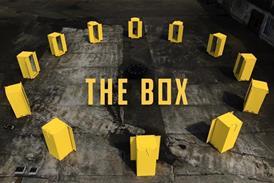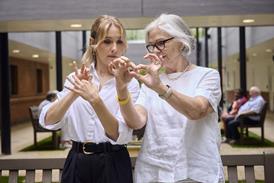Matthew Bell dissects Pioneer Productions' forthcoming documentary Animals in the Womb and examines what it is possible to achieve creatively in audio
Pioneer Productions' Animals in the Wombtakes the viewer into the wombs of a pregnant Asian elephant, dolphin and golden retriever using scientifically based computer animation and pictures from the latest ultra-sound scanners.
So far, so factual. But for the sound designer and composer, the task of building a soundtrack for the film required a giant leap of imagination; after all, no one really knows what sounds can be heard inside the wombs of animals.
The documentary is a sequel to Pioneer's In the Womb, 2005's groundbreaking documentary for Channel 4 and National Geographic Channel that explored the development of a human foetus from conception to birth.
The London-based film-maker Yavar Abbas ??? often known as the Satyajit Ray of Indian documentary cinema ??? initially harboured doubts about directing the film: 'Pioneer phoned me up and asked me if I fancied doing a programme on foetal development in animals, which I thought about and then laughed. I'd never done anything on animals before. My main worry was: 'Oh gosh, a wildlife film', but, in fact, it was more of a science documentary. I'm very glad I took it.' The film airs on C4 later this year.
Scoring the film
Abbas listened to the composer Duncan Glasson's reel and immediately felt his style suited the programme. 'The music had to be a combination of epic and sweeping, but also intimate and simple because a womb is such a small, enclosed environment. It was quite a difficult brief,' says Abbas. 'I think it was a bit of a challenge for Duncan because by his own admission he likes to do sweeping and cinematic scores.'
Glasson, who has worked on Pioneer productions including Amazon Adventuresand Naked Science, received an 'extremely loose' brief. 'I had probably a three-minute conversation with Yavar and then wrote [an initial] 25 pieces of music,' he recalls. 'I didn't get to see any of the visuals at all. You just have to be able to put on your thinking hat as a composer.'
As is the way with most TV nowadays, time is at a premium. 'You find out the programme content and off you go,' says Glasson. 'I'll write for five days pretty much constantly and then send it in and get some feedback. The way it is now you don't get a lot of time to write to picture. Everybody wants to see an almost finished product pretty much four weeks into the edit.'
Glasson composed the score for Animals in the Wombusing orchestral samples and music software programmes Apple Logic and Ableton Although he describes himself as 'a multi-instrumentalist', the score, which in total is composed of almost 100 pieces, is entirely electronic. 'When you've got your computer in front of you, your keyboard can be a piano, a harp, fantastic strings or an orchestral brass section - all through a Mac G5,' he says.
Technology has moved on apace since Glasson, who has also mixed records by the likes of Britney Spears and Sophie Ellis Bextor, began working in sound as a record producer at the start of the 1990s. Even then, Glasson was using computers to write his scores, although he recalls that his first machine, an Atari, had no hard drive at all. 'Now I can stream orchestral samples from your hard drive as opposed to having a crappy synthesiser trying to sound like an orchestra,' he says.
Since 2000, Glasson has worked solely as a composer on short films, documentaries, commercials and dramas. 'Scores are now all computer-based, even if you're going to record guitars or mandolins or get a singer in. The guy with the tape machine has long gone,' he says.
For Animals in the Womb, Glasson used a palette of orchestral instruments to convey the mystery and wonder of conception, pregnancy and birth. The score has a cinematic sweep, rather than the quirky themes that producers often demand for wildlife documentaries. 'If they'd asked me to produce a humorous set of pieces I would have said they needed someone else,' says Glasson.
Sound effects
The sound design had to work both with Glasson's score and some startling visual effects. Physical effects company Artem built models for each stage of the animals' pregnancies, while computer-generated effects were provided by Steve Gomez from Bandito. 'Steve did CGI animation of the sperm fertilising the egg and morphed each animal from a sort of blob into a fully formed foetus,' says Abbas. A 4-D ultra-sound scanner brought shots of the developing foetuses from inside the womb. This scanner, unlike traditional models, captures the image in real time, adding a fourth dimension to the shots. 'These are pictures never seen before. It's a well-worn phrase but in this case we really can say it's the first time on television,' says Abbas.
Matt Faulkner from Rainbow Post Production, which is part of the Pioneer Media Group, is credited as dubbing mixer on Animals in the Womb, but his role was much wider and included all the programme's sound design and effects. 'The film has three audio elements: the commentary, music and sound effects. For pretty much every scene there has to be a full sound effects track laid down to accompany the music,' he says.
Faulkner also mixed In the Wombbut the sequel, because it features three animal pregnancies rather than a single human foetus, threw up more challenges. 'I wanted to create three very different kind of environments. A lot of the sounds are similar but I had to give a different impression for each one: the scale of the elephant; the water environment of the dolphin; and the multiple foetuses within the golden retriever. There's a sense of them moving around and interacting a bit with each other,' he says. 'The amazing models and computer graphics that were made were delivered mute so they had to be brought to life.
The sound design in many places is not meant to be entirely realistic or literal. Many of the CGI sequences of sperm, embryos and cells give an impressionistic sense of the sound or help the explanation of the scene.'
The source material from which Faulkner created his sound design came from Rainbow's own and outside sound effects libraries. 'From those sounds you can grasp an idea that you create the sound from. There's no sound effect library designed for programmes like this,' he says.
Faulkner then played around on his mixing desk with effects machines, reverb units and samplers to build his sound design. The result is that the sounds inside the womb are low-level, made up of bleeps, echoes and ripples.
As well as the animation and ultra-sound shots from the womb, Animals in the Wombuses archive and new footage of elephants, dolphins and the golden retriever to which Faulkner has added a soundtrack of effects.
For some animal movements, he also added his own foley recordings. 'The amount that needed to be done didn't quite warrant hiring a foley artist [who physically recreates sounds], and also it's good fun to do,' he says.
To create animal eating noises, he explains, 'we were scrunching things and making big movements with our own mouths. We then used the power of the mixing desk to enhance that sound.'
The edit
'In a film so intimate the sound design, inside the womb certainly, is very important for telling the story,' says freelance editor Tom Ash, a regular on Pioneer productions. 'The exterior shots of the animals are [generally] natural sound; the interiors ones have more strange and echoey effects.'
Faulkner provided Ash with his sound design for the initial edit. 'It was a case of selecting what felt right for the level of intimacy of the shots in the womb and laying that over. A lot of [the design] had been pre-prepared, which was very helpful,' recalls Ash. 'For me, the first stage is making sure the [sounds] fit with the picture and then it goes back over to Matt to refine the levels and add some extra strange effects that he thinks are going to help,' he adds.
In the cutting room Ash added his own foley work, using 'some crumpled up bits of plastic to sound like a shrew running around. Matt basically takes what I've done and makes it sound better.'
The editor also recorded a guide commentary by Yavar, which he later replaced with narration from radio presenter/producer and TV voiceover queen Dilly Barlow. In turn, National Geographic channel will remove her voiceover and dub a US version.
The US mix
Ash has completed the final edit on National Geographic's 100-minute high-definition version and is now working on a 75-minute cut for C4.
'Delivery to National Geographic was in 5.1 surround sound, which really brought to life the world within the womb,' recalls Faulkner.
'National Geographic demands a very specific delivery, encoded in Dolby E. This is a system of taking a multi-track 5.1 surround sound mix, which is essentially six speaker feeds of audio, and then coding so that it can fit onto two channels of a digital tape format. This means that we can deliver it to them nice and neatly on a Panasonic [HD format] D5 tape with Dolby E encoded data streams.'
Experience counts
Both Glasson and Faulkner are hugely experienced sound men. The composer has racked up 15 years of TV work, while the dubbing mixer is in his 10th year. 'I may have got it completely wrong, but you have to create a world that suits [the pictures],' says Faulkner. 'There's a lot of head scratching and fiddling around trying things out until you get something that works with the voice-over and feels right for the music.'
For Glasson, the composer's lot is that of a multi-tasker. 'Whether you're doing beautiful orchestral work or ITV1's David Beckham - A Footballer's Story, which was all hip hop, if there's any rule, it's that you've got to be prepared to write across vastly different genres of music.'
Describing his score as 'cinematic', Glasson adds: 'There's emotion in a lot of what I write. If it gives me goose pimples, then I think I've done my job well.'
Animals in the Womb is a Pioneer Productions co-production with Fox for National Geographic Channel, National Geographic International, Channel4 and Channel 4 International






























No comments yet